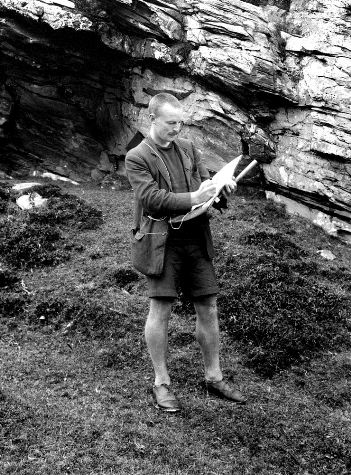
Picture: Sir Edward Battersby Bailey in field gear. Photo Courtesy NERC - British Geological Survey Image No P225785.
Geologist and science writer Nina Morgan considers changing fashions in field gear
For many geologists who enjoy unravelling complex geological features, a day outdoors facing the elements is all part of the challenge. But for others the idea of getting cold, wet, windswept and muddy is considered a drawback, and could help to explain the declining attraction of field trips among geology students (See: Adapt or Die! Geoscientist April 2014). These days, new generations of high tech fabrics and expensive 'performance' clothing are available to keep field geologists warm and dry. But in the past, finding suitable outdoor gear was more a question of ‘make do and mend’.
In October 1841 the geologist John Phillips, tramping through deep mud with no solid footing on the lanes of Carmarthenshire and then enduring five days of fierce storms, wrote to his sister Anne to ask her to have a specially designed cloak of oiled silk made up and sent to him to fend off the rain. This makeshift solution obviously worked, since Phillips was able to carry on with his Welsh fieldwork until the end of the year without, he reported, even catching a cold (Distant Thunder, September 2011).
Embracing the elements
Rather than relying on clever clothing to shelter from the weather, geologist Edward Battersby Bailey [1881 – 1965, pictured], positively embraced the weather. Bailey joined the Edinburgh office of the Geological Survey of Great Britain in 1902 and was assigned to Benjamin Peach [1842 – 1926] for training in geological mapping on the six-inch to a mile scale in Highland terrain. He left the Survey in 1930 to take a chair at the University of Glasgow, then rejoined as Director in 1937, retiring finally in 1945. From childhood onwards, legends abound about his determination and toughness.
His tenure at the Survey was interrupted by the First World War when he served from 1915 to 1919 with the Royal Garrison Artillery. Although he was wounded twice, losing his left eye and much use of his left arm, he remained legendary in the Survey for the speed with which he covered the ground.
His fashion sense in field was also notorious. He wore shorts in all weathers and all seasons. These were topped by a shabby jacket with various pieces of equipment tied on with string. He eschewed socks, believing that they would only get wet. And for a similar reason he was rumoured to cut the toes out of new shoes so that the water could run out. (Not that wet feet seemed to bother him. Legend has it that he would stand in a stream first thing in the morning so that he didn't have to worry about getting his feet wet for the rest of the day, and then eat his packed lunch so that he didn't have to carry it and waste time eating it later.)
Clothes maketh man
Bailey, a master at tracing out large-scale structures, apparently put down much of his success in the field to this idiosyncratic attire. When in 1905 the Survey powers-that-be instructed him to wear ‘more formal’ attire in the field, he promptly resigned, explaining that he didn't believe he could do justice to his mapping if he dressed differently. The order was rescinded, and Bailey – who carried on with fieldwork long after his retirement - continued to wear shorts in the field for the rest of his (long) life.
Acknowledgements
Sources for this vignette include: The Dalradian rocks of Scotland by David Stephenson, John Mendum, Douglas Fettes and A Graham Leslie, Proceedings of the Geologists' Association, vol. 124, (2013), pp. 3 – 82; Edward Battersby Bailey by C James Stubblefield, Biogr. Mems. Fell. Roy. Soc., v11, (1965) pp 1-21; the entry for Edward Battersby Bailey by C James Stubblefield in the Dictionary of National Biography; and a letter dated 9 October 1841 from John Phillips to Anne Phillips in the archive of the Oxford University Museum of Natural History.
* Nina Morgan is a geologist and science writer based near Oxford. Her latest book, The Geology of Oxford Gravestones, is available via www.gravestonegeology.uk